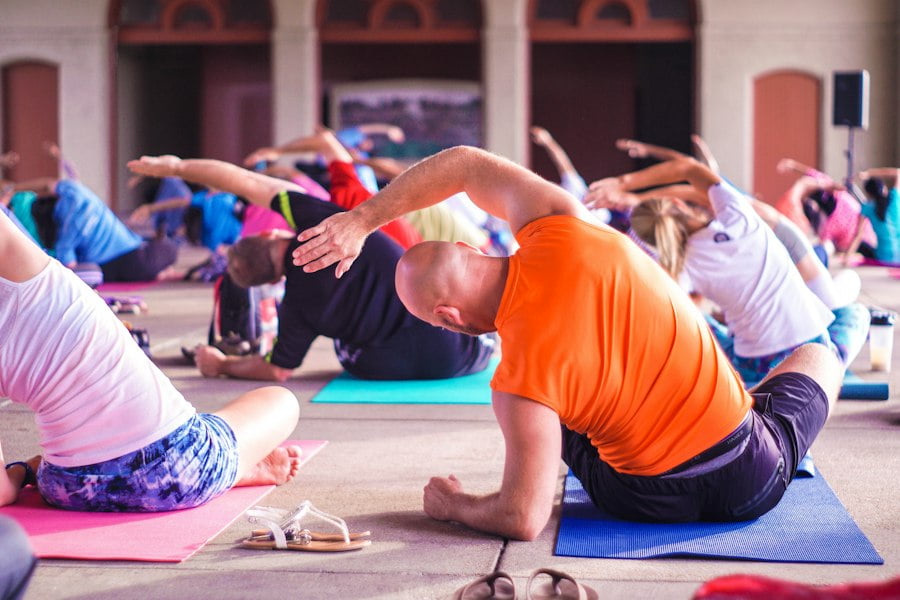
The impact of exercise on mental health and mood regulation
Exercise has long been recognized for its physical health benefits, but its impact on mental health is equally significant. Research has shown that regular exercise can have a positive effect on anxiety, depression, mood regulation, stress reduction, self-esteem, and even as a complementary therapy for mental health disorders. It is important to discuss the relationship between exercise and mental health to raise awareness and encourage individuals to incorporate physical activity into their daily routines.
Mental health is a topic that is often stigmatized and overlooked, but it affects millions of people worldwide. By discussing the connection between exercise and mental health, we can help reduce the stigma surrounding mental health issues and promote overall well-being. It is crucial to recognize that mental health is just as important as physical health and that taking care of our minds is essential for leading a fulfilling life.
Key Takeaways
- Exercise has a strong connection to mental health and can be used as a complementary therapy for mental health disorders.
- Regular exercise can reduce symptoms of anxiety and depression and improve mood regulation by affecting brain chemistry.
- Physical activity can also help reduce stress and improve coping mechanisms, leading to better mental health outcomes.
- Exercise can enhance self-esteem and body image, leading to increased confidence and overall well-being.
- Choosing the right type of exercise and building social support can also contribute to better mental health outcomes.
Mental Health Benefits of Exercise: Reducing Anxiety and Depression Symptoms
Numerous studies have shown that exercise can significantly reduce symptoms of anxiety and depression. Physical activity releases endorphins, which are chemicals in the brain that act as natural painkillers and mood elevators. These endorphins help improve mood and reduce feelings of anxiety and depression.
In addition to endorphins, exercise also increases the production of other chemicals in the brain, such as serotonin and dopamine, which are known to regulate mood. Regular exercise can also improve sleep patterns, increase self-confidence, and provide a sense of accomplishment, all of which contribute to improved mental well-being.
Personal stories and examples can further illustrate the positive effects of exercise on mental health. For instance, Sarah, a 35-year-old woman who struggled with anxiety for years, found that incorporating regular exercise into her routine significantly reduced her symptoms. She noticed that after a workout session, her mind felt clearer, her anxiety levels decreased, and she felt more energized throughout the day.
The Role of Exercise in Mood Regulation: How it Affects Brain Chemistry
Exercise has a direct impact on brain chemistry and mood regulation. When we engage in physical activity, our brain releases endorphins, which are neurotransmitters that act as natural painkillers and mood enhancers. These endorphins interact with receptors in the brain to reduce feelings of pain and increase feelings of pleasure and well-being.
In addition to endorphins, exercise also increases the production of serotonin and dopamine, two neurotransmitters that play a crucial role in regulating mood. Serotonin is often referred to as the “feel-good” chemical because it helps promote feelings of happiness and well-being. Dopamine, on the other hand, is involved in motivation and reward, and its release during exercise can contribute to a sense of accomplishment and satisfaction.
Regular exercise can also improve overall mental health and well-being by reducing inflammation in the brain, increasing blood flow, and promoting the growth of new brain cells. These physiological changes can lead to improved cognitive function, better memory, and enhanced overall mental health.
Physical Activity and Stress Reduction: Improving Coping Mechanisms
Exercise has been shown to have a significant impact on stress levels and coping mechanisms. When we engage in physical activity, our body releases stress hormones such as cortisol, which helps us respond to stressful situations. However, regular exercise can help regulate cortisol levels, preventing them from becoming chronically elevated.
Exercise also provides an outlet for pent-up energy and emotions, allowing individuals to release tension and reduce feelings of stress and anxiety. Physical activity can serve as a healthy coping mechanism, providing a distraction from negative thoughts and promoting a sense of calmness and relaxation.
Incorporating exercise into a stress-reduction routine can be beneficial for individuals who struggle with managing stress and anxiety. Some tips for incorporating exercise into a stress-reduction routine include finding activities that you enjoy, setting realistic goals, and making exercise a priority in your daily schedule. Whether it’s going for a walk, practicing yoga, or participating in a team sport, finding an activity that suits your preferences and fits into your lifestyle is key to reaping the stress-reducing benefits of exercise.
Exercise and Self-Esteem: Enhancing Body Image and Confidence
Exercise has a profound impact on self-esteem and body image. Regular physical activity can improve body image by promoting weight loss, toning muscles, and increasing overall fitness levels. When individuals see positive changes in their physical appearance as a result of exercise, they often experience an increase in self-confidence and self-esteem.
Engaging in regular exercise can also provide individuals with a sense of accomplishment and mastery over their bodies. Setting and achieving fitness goals can boost self-esteem and provide a sense of empowerment. Additionally, exercise releases endorphins, which can improve mood and contribute to an overall positive outlook on life.
It is important to note that exercise should not be solely focused on achieving a certain body type or appearance. The emphasis should be on overall health and well-being rather than solely on physical appearance. By shifting the focus from external validation to internal satisfaction, individuals can cultivate a healthier relationship with exercise and enhance their self-esteem.
Exercise as a Treatment for Mental Health Disorders: Complementary Therapy

Exercise can be used as a complementary therapy for mental health disorders such as depression, anxiety, and even schizophrenia. While it is not a substitute for medication or therapy, regular physical activity can enhance the effects of other treatments and improve overall mental well-being.
For individuals with depression, exercise has been shown to increase the production of endorphins and other neurotransmitters that regulate mood. It can also provide a sense of structure and routine, which is often lacking in the lives of individuals with depression.
In the case of anxiety disorders, exercise can help reduce symptoms by promoting relaxation and reducing tension. Physical activity can also serve as a distraction from anxious thoughts and provide individuals with a sense of control over their bodies and minds.
When using exercise as a complementary therapy, it is important to consult with a healthcare professional to ensure that it is safe and appropriate for your specific condition. They can provide guidance on the type and intensity of exercise that is most beneficial for your mental health needs.
The Importance of Consistency: Maintaining Mental Health Through Regular Exercise
Consistency is key when it comes to reaping the mental health benefits of exercise. While a single workout session can provide temporary relief from symptoms such as anxiety or depression, regular physical activity is necessary to maintain long-term mental well-being.
Regular exercise helps regulate brain chemistry, improve sleep patterns, and reduce stress levels. It also provides individuals with a sense of routine and structure, which can be particularly beneficial for those struggling with mental health disorders.
To maintain a regular exercise routine, it is important to set realistic goals, find activities that you enjoy, and make exercise a priority in your daily schedule. It can be helpful to establish a routine by exercising at the same time each day or on specific days of the week. Additionally, finding an accountability partner or joining a group exercise class can provide motivation and support.
Choosing the Right Exercise for Your Mental Health Needs: Aerobic vs. Anaerobic
When it comes to choosing the right type of exercise for your mental health needs, it is important to consider both aerobic and anaerobic activities. Aerobic exercise, such as running, swimming, or cycling, increases heart rate and oxygen consumption, leading to improved cardiovascular fitness and increased endorphin production.
Anaerobic exercise, on the other hand, focuses on strength training and high-intensity interval training (HIIT). These activities help build muscle strength and endurance while also increasing endorphin production. Examples of anaerobic exercises include weightlifting, circuit training, and sprinting.
The choice between aerobic and anaerobic exercise depends on individual preferences and goals. Some individuals may find that aerobic exercise, such as running or swimming, provides a sense of calmness and relaxation, while others may prefer the intensity and challenge of anaerobic activities.
It is important to listen to your body and choose activities that you enjoy and that align with your fitness level. The key is to find an exercise routine that you can stick to and that brings you joy and satisfaction.
Exercise and Social Support: Building Community and Connection for Better Mental Health
Social support is crucial for mental health, and exercise can be a powerful tool for building community and connection. Participating in group exercise activities or joining a sports team can provide individuals with a sense of belonging and camaraderie.
Group exercise classes, such as yoga or dance classes, offer an opportunity to meet like-minded individuals who share similar interests. These classes often foster a supportive and inclusive environment where individuals can connect with others while improving their physical and mental well-being.
Sports teams or recreational leagues provide an additional avenue for building social connections. Whether it’s joining a soccer team or participating in a running club, these activities allow individuals to bond over a shared passion for physical activity while also providing opportunities for social interaction.
Exercise can also be used as a social activity with friends or family members. Going for a walk or bike ride together not only promotes physical health but also strengthens relationships and provides an opportunity for quality time spent together.
Overcoming Barriers to Exercise: Strategies for Incorporating Physical Activity into Your Mental Health Routine
While the benefits of exercise for mental health are well-established, there are often barriers that prevent individuals from incorporating physical activity into their routines. Common barriers include lack of time, lack of motivation, physical limitations, or feeling overwhelmed by the thought of starting an exercise routine.
To overcome these barriers, it is important to practice self-care and self-compassion. Start by setting realistic goals and gradually increasing the intensity and duration of your workouts. Remember that any form of physical activity is better than none, so even a short walk or a few minutes of stretching can make a difference.
Finding activities that you enjoy and that align with your interests and preferences can also help overcome barriers to exercise. If you dislike running, try swimming or dancing instead. Experiment with different activities until you find something that brings you joy and makes you feel good.
It can also be helpful to enlist the support of a friend or family member. Having an accountability partner can provide motivation and support, making it easier to stick to an exercise routine. Additionally, seeking professional guidance from a personal trainer or exercise specialist can help ensure that you are engaging in safe and effective workouts.
In conclusion, the connection between exercise and mental health is undeniable. Regular physical activity has been shown to reduce symptoms of anxiety and depression, improve mood regulation, reduce stress levels, enhance self-esteem, and even serve as a complementary therapy for mental health disorders. By understanding the benefits of exercise for mental health and implementing strategies to overcome barriers, individuals can improve their overall well-being and lead happier, healthier lives.
If you’re interested in exploring more about the connection between exercise and mental health, you might find this article from Wave Magnets intriguing. Titled “The Power of Mindfulness Meditation in Enhancing Mental Well-being,” it delves into the benefits of incorporating mindfulness meditation into your exercise routine. Discover how this practice can further enhance mood regulation and overall mental well-being. Check out the article here to learn more.
FAQs
What is the impact of exercise on mental health?
Exercise has been shown to have a positive impact on mental health by reducing symptoms of depression, anxiety, and stress. It can also improve self-esteem and cognitive function.
How does exercise affect mood regulation?
Exercise can increase the production of endorphins, which are chemicals in the brain that can improve mood and reduce pain. It can also reduce levels of cortisol, a hormone associated with stress.
What types of exercise are best for mental health?
Any type of exercise can be beneficial for mental health, but aerobic exercise such as running, cycling, or swimming has been shown to have the most positive impact.
How often should I exercise to see mental health benefits?
Research suggests that exercising for at least 30 minutes, three to five times per week can have a positive impact on mental health.
Can exercise be used as a treatment for mental health disorders?
Exercise can be used as a complementary treatment for mental health disorders such as depression and anxiety, but it should not be used as a substitute for professional medical treatment. It is important to consult with a healthcare provider before starting an exercise program.


















